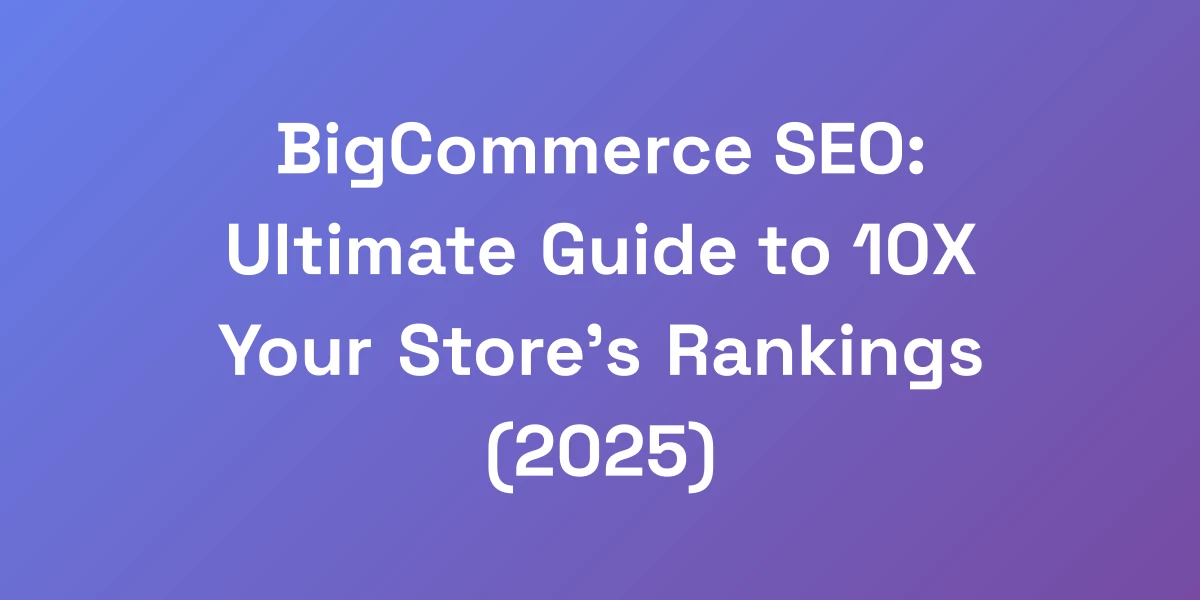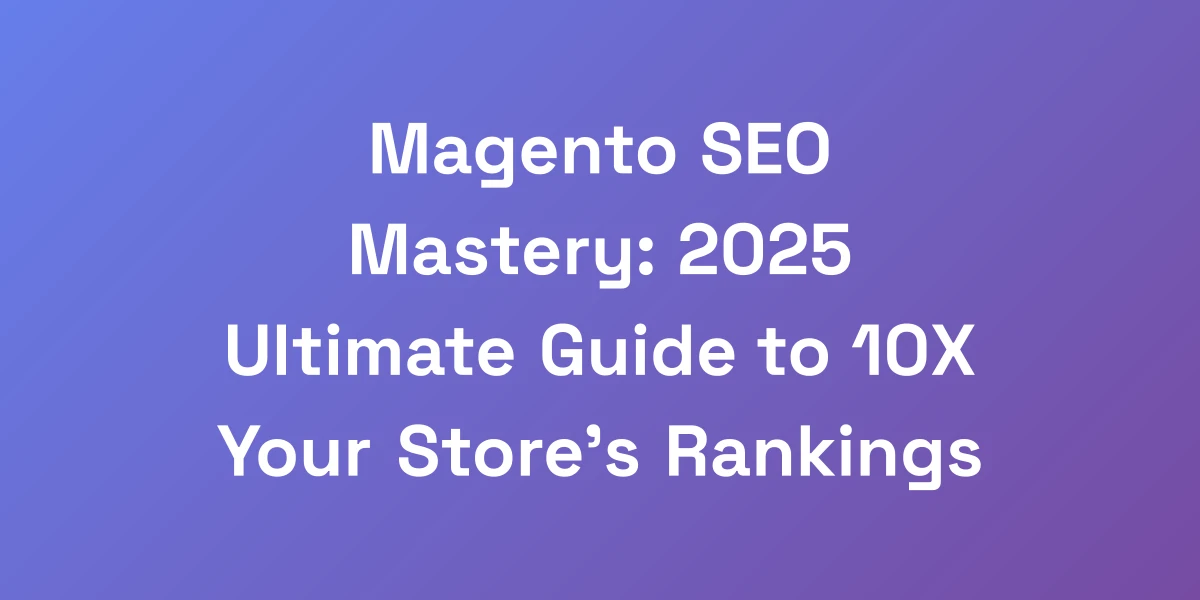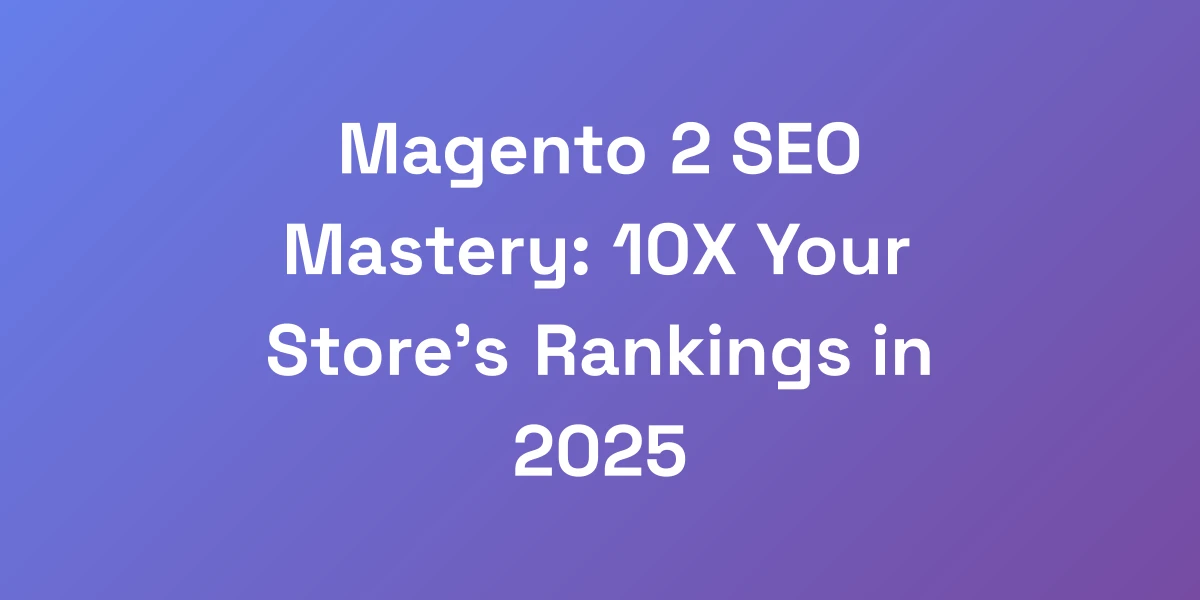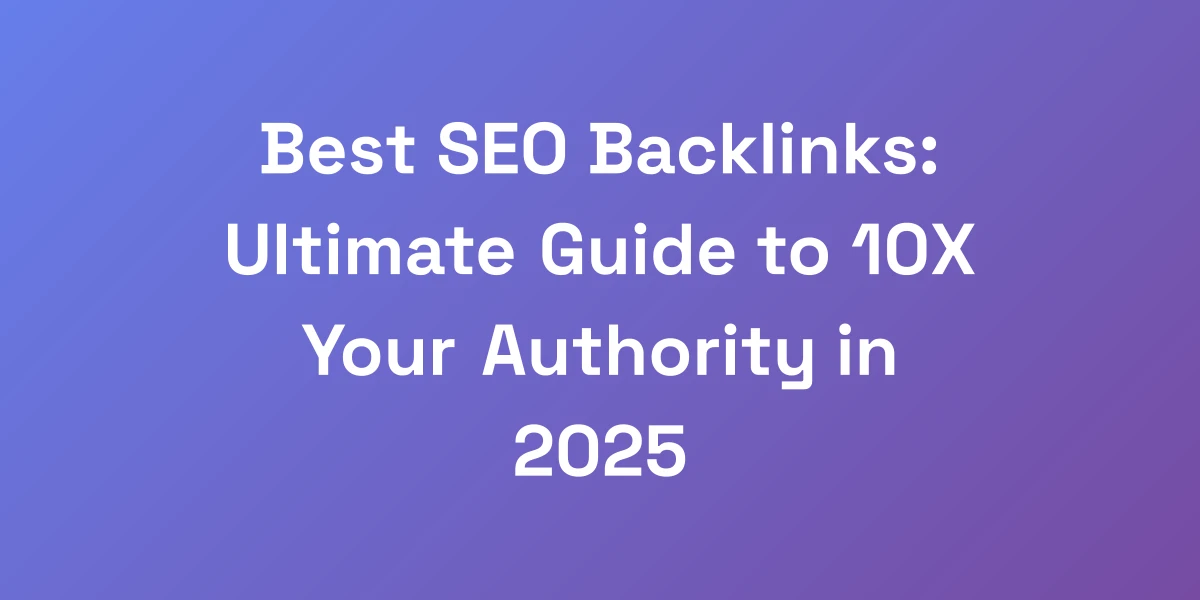
BigCommerce SEO: Ultimate Guide to 10X Your Store’s Rankings (2025)
Mar 7, 2025 | By [email protected]
Introduction
Let’s face it—running a BigCommerce store is no walk in the park. You’ve got products to sell, customers to impress, and competitors breathing down your neck. But here’s the kicker: 90% of BigCommerce store owners are leaving money on the table because they don’t get the real deal about SEO. It’s not just about stuffing keywords into your product descriptions anymore.
SEO today is about building a complete digital ecosystem that Google can’t ignore. Imagine having a store that not only attracts visitors but converts them into loyal customers effortlessly. Sounds like a dream, right? Well, it’s not. I’ve helped scale multiple 8-figure ecommerce brands, and trust me, the difference between ranking on page 1 and page 7 is crystal clear.
The secret? Systematic implementation of proven strategies that most store owners completely overlook, as outlined in our BigCommerce SEO strategy. This guide is your roadmap to navigating the BigCommerce SEO maze, giving you actionable tips and strategies to 10X your store’s rankings by 2025. Ready to turn your BigCommerce store into an SEO powerhouse? Let’s dive in.
Why Most BigCommerce Stores Fail at SEO (And How to Fix It)
Let me be direct – 90% of BigCommerce store owners are leaving money on the table because they don’t understand one simple truth: SEO isn’t just about keywords anymore. It’s about building a complete digital ecosystem that Google can’t ignore. I’ve helped scale multiple 8-figure ecommerce brands, and I’ll tell you exactly what separates the winners from the losers in the BigCommerce SEO game. The difference between ranking on page 1 versus page 7 comes down to systematic implementation of proven strategies that most store owners completely overlook.
Common SEO Mistakes Killing Your BigCommerce Store’s Potential
Are you making these rookie SEO mistakes? Let’s uncover the top culprits:
- Ignoring Mobile Optimization: With Google’s mobile SEO best practices, a non-mobile-friendly site is a death sentence for rankings.
- Duplicate Content: Duplicate product descriptions confuse search engines and dilute your SEO efforts.
- Poor Site Structure: A tangled site structure hampers both user experience and crawlability.
- Neglecting Meta Descriptions: Meta descriptions are your first impression in search results. Don’t leave them blank.
- Slow Page Load Times: Users and search engines despise slow-loading pages. Speed up or watch your rankings drop.
Avoiding these pitfalls is just the beginning. To truly dominate BigCommerce SEO, you need to go beyond the basics.
The Real Cost of Poor SEO Implementation
Think SEO is optional? Think again. Poor SEO implementation can cost you big time:
- Lost Revenue: Every day you’re not ranking, you’re missing out on potential sales.
- Decreased Visibility: Poor SEO means your store is buried under competitors, invisible to your target audience.
- Wasted Resources: Poorly optimized SEO efforts waste time and money with little to no return.
- Brand Reputation: Low rankings can make your store appear less credible and trustworthy.
Investing in proper SEO is not just a good idea—it’s essential for the survival and growth of your BigCommerce store.
Understanding Google’s E-E-A-T for E-commerce
Google’s E-E-A-T—Experience, Expertise, Authoritativeness, and Trustworthiness—has evolved to place even more emphasis on experience. For e-commerce, this means your content must not only be accurate but also demonstrate firsthand knowledge. How?
- Detailed Product Descriptions: Go beyond features. Explain how your products solve problems.
- Customer Reviews: Authentic user-generated content boosts trust and credibility.
- Authoritative Content: Publish content that showcases your expertise in your niche.
- Transparent Policies: Clear return, shipping, and privacy policies enhance trustworthiness.
Mastering E-E-A-T is a game-changer. It’s not just about pleasing Google—it’s about building a trustworthy brand that customers love.
Quick Wins vs. Long-term Strategy
SEO is a marathon, not a sprint. While quick wins can provide immediate boosts, long-term SEO strategies ensure sustained growth. Here’s how to balance both:
- Quick Wins: Optimize meta tags, fix broken links, and improve page load times. These can provide immediate improvements.
- Long-term Strategy: Develop a robust content marketing plan, build high-quality backlinks, and continuously optimize your site structure.
Focusing solely on quick wins might give you a short-term boost, but integrating them into a comprehensive long-term strategy is what will 10X your rankings.
Setting Realistic SEO Goals for Your Store
Setting lofty goals is easy, but realistic ones require insight and planning. Here’s how to set SEO goals that align with your BigCommerce store’s growth:
- Define Clear Objectives: Whether it’s increasing organic traffic, improving conversion rates, or boosting revenue, clarity is key.
- Use SMART Goals: Specific, Measurable, Achievable, Relevant, and Time-bound goals keep you on track.
- Monitor Progress: Regularly track your performance against your goals using tools like Google Analytics and SEMrush.
- Adjust Accordingly: SEO is dynamic. Be prepared to pivot your strategy based on performance data and algorithm updates.
Realistic goals provide direction and motivation, ensuring your SEO efforts are both effective and sustainable.
Technical SEO Fundamentals That Move the Needle
Listen carefully because this is where most “SEO experts” get it wrong. Technical SEO isn’t about checking boxes – it’s about creating a foundation that multiplies every other optimization effort. I’ve seen stores double their organic traffic just by fixing these technical elements correctly. The key is understanding that BigCommerce gives you specific advantages in technical SEO that most platforms don’t offer. To learn more, check out our BigCommerce SEO guide. But here’s the catch – you need to know exactly how to leverage these features to maximize their impact.
Optimizing URL Structure for Maximum Impact
Your URL structure is the backbone of your site’s SEO. A clean, logical URL helps search engines understand your site better and can improve rankings. Here’s how to optimize:
- Use Descriptive Keywords: Incorporate primary keywords naturally into your URLs.
- Keep it Simple: Short, concise URLs are easier for both users and search engines to understand.
- Avoid Unnecessary Parameters: Clean URLs without excessive parameters are preferred by search engines.
- Consistent Structure: Maintain a uniform structure across all pages for better crawlability.
A well-optimized URL structure not only boosts your SEO but also enhances user experience, making it easier for customers to navigate and share your content.
Advanced Schema Markup Implementation
Schema markup is your secret weapon for standing out in search results. It helps search engines understand your content and can lead to rich snippets. Here’s how to implement it effectively:
- Product Schema: Include details like price, availability, and reviews to make your product pages shine.
- Breadcrumb Schema: Enhance navigation by showing breadcrumb trails, which improve user experience and SEO.
- Review Schema: Display star ratings and reviews directly in search results, boosting credibility and click-through rates.
- FAQ Schema: Provide quick answers to common questions, increasing your chances of appearing in featured snippets.
Proper schema implementation can significantly enhance your search visibility, making your BigCommerce store more attractive to potential customers.
Site Speed Optimization Techniques
Site speed is a critical factor for both user experience and SEO. A slow-loading site can deter customers and harm your rankings. Here’s how to boost your BigCommerce store’s speed:
- Optimize Images: Use compressed images without sacrificing quality to reduce load times.
- Leverage Browser Caching: Store static files in users’ browsers to speed up subsequent visits.
- Minify CSS and JavaScript: Reduce file sizes by removing unnecessary code and spaces.
- Use a Content Delivery Network (CDN): Distribute your content across multiple servers to enhance load times globally.
- Enable GZIP Compression: Compress files sent from your server to speed up data transfer.
Implementing these techniques can drastically improve your site’s performance, leading to higher rankings and better user engagement.
Mobile-First Indexing Optimization
With Google’s mobile-first indexing, your site’s mobile version is what counts for rankings. Here’s how to ensure your BigCommerce store is mobile-optimized:
- Responsive Design: Ensure your site adapts seamlessly to different screen sizes and devices.
- Fast Mobile Load Times: Mobile users expect quick access. Optimize for speed, just like on desktop.
- Accessible Navigation: Simplify navigation for mobile users with clear menus and clickable elements.
- Readable Content: Use fonts, sizes, and layouts that are easy to read on smaller screens.
- Touch-Friendly Elements: Ensure buttons and links are easy to tap without errors.
Optimizing for mobile-first indexing is non-negotiable. It’s about providing a seamless experience for mobile users, which directly impacts your SEO performance.
XML Sitemap and Robots.txt Configuration
An XML sitemap and a well-configured robots.txt file are essential for guiding search engines through your site. Here’s how to get them right:
- XML Sitemap: Ensure all important pages are included and regularly updated. BigCommerce typically generates this automatically, but double-check for completeness.
- Robots.txt: Use this file to manage which pages search engines can crawl. Disallow irrelevant or duplicate content to streamline your site’s crawl efficiency.
- Submit Sitemap: Submit your XML sitemap to Google Search Console to facilitate faster indexing.
Proper sitemap and robots.txt configuration can enhance how search engines crawl and index your site, improving your overall SEO health.
JavaScript SEO for BigCommerce
JavaScript can both empower and hinder your SEO efforts. Here’s how to manage it effectively:
- Server-Side Rendering (SSR):strong> Implement SSR to ensure search engines can crawl your JavaScript content.
- Dynamic Rendering: Serve static HTML to search engines while delivering dynamic content to users.
- Lazy Loading: Use lazy loading for images and videos to enhance site speed without compromising SEO.
- Avoid Excessive JavaScript: Too much JavaScript can slow down your site and confuse search engine crawlers.
Mastering JavaScript SEO ensures that your dynamic content is accessible and indexable, maintaining high search engine rankings.
Content Optimization Strategies That Actually Drive Sales
Here’s the brutal truth about content in e-commerce: most product descriptions are garbage. They focus on features instead of benefits and completely miss the psychological triggers that drive purchases. I’ve developed a framework that has consistently generated 7-figure revenue increases through organic search alone. The secret? Understanding that every piece of content needs to serve both the search engines and the buyer’s psychology. Let me show you exactly how to do this. For more insights, refer to our BigCommerce SEO tips.
Product Page Optimization Framework
Your product page is the heart of your BigCommerce store. Here’s how to optimize it for maximum impact:
- Engaging Product Titles: Use clear and descriptive titles with primary keywords.
- Compelling Product Descriptions: Highlight benefits over features. Tell a story that resonates with your customers.
- High-Quality Images and Videos: Show your product from multiple angles and include usage videos to boost engagement.
- Structured Data: Implement schema markup for products, reviews, and ratings to enhance search visibility.
- Clear Call-to-Actions (CTAs):strong> Encourage conversions with strong, action-oriented CTAs.
Optimizing your product pages not only improves SEO but also increases conversion rates by addressing customer needs and search intent effectively.
Category Page Content Strategy
Category pages are more than just a collection of products. They’re opportunities to target broader keywords and guide user navigation. Here’s how to maximize them:
- Descriptive Category Titles: Use primary keywords in your category titles to improve visibility.
- Informative Category Descriptions: Write unique descriptions that provide value and incorporate relevant keywords.
- Internal Linking: Link to related products and sub-categories to enhance site structure and SEO.
- User-Friendly Navigation: Ensure your category pages are easy to navigate with clear filters and sorting options.
- Optimized Images: Use images that represent the category and are optimized for fast loading.
A well-optimized category page drives traffic, improves user experience, and boosts your store’s overall SEO performance.
Blog Content That Converts
Blogging is a powerful tool for driving organic traffic and establishing authority. Here’s how to create blog content that drives sales:
- Target Long-Tail Keywords: Focus on specific queries that your target audience is searching for.
- Provide Value: Create content that solves problems, answers questions, and provides actionable insights.
- Incorporate Internal Links: Link to relevant products, category pages, and other blog posts to enhance SEO and user engagement.
- Engaging Formats: Use a mix of articles, guides, infographics, and videos to keep your audience engaged.
- Regular Updates: Keep your blog active with regular posts to maintain and grow your organic traffic.
Effective blogging not only drives traffic but also nurtures leads and converts them into customers by building trust and authority.
User-Generated Content Integration
Leveraging user-generated content (UGC) can significantly enhance your SEO and build trust with potential customers. Here’s how:
- Customer Reviews: Encourage customers to leave honest reviews on your product pages.
- Testimonials: Showcase testimonials on landing pages to build credibility.
- Social Proof: Integrate UGC from social media platforms to demonstrate real-world use and satisfaction.
- Q&A Sections: Allow customers to ask and answer questions about your products.
- Photo and Video Submissions: Let customers share photos and videos of them using your products.
UGC not only enriches your content but also signals to search engines that your site is active and trustworthy.
Rich Snippets Optimization
Rich snippets make your listings stand out in search results with additional information like ratings, prices, and availability. Here’s how to optimize for them:
- Implement Schema Markup: Use product, review, and price schema to enhance your snippets.
- Encourage Reviews: More reviews mean more chances for rich snippet features like star ratings.
- Keep Data Updated: Ensure your rich snippet data is accurate and up-to-date to avoid discrepancies.
- Use Structured Data Testing Tools: Validate your schema markup using tools like Google’s Structured Data Testing Tool.
Optimizing rich snippets can significantly improve your click-through rates by making your listings more appealing and informative.
Content Hierarchy and Internal Linking
Structuring your content hierarchy and internal linking effectively can boost both SEO and user experience. Here’s how:
- Logical Structure: Organize your content in a logical hierarchy, from broad topics to specific details.
- Breadcrumb Navigation: Implement breadcrumb trails to help users and search engines navigate your site.
- Internal Links: Connect related content through internal links to distribute link juice and enhance SEO.
- Anchor Text Optimization: Use descriptive and keyword-rich anchor text for your internal links.
- Content Silos: Group related content into silos to strengthen topic authority and improve crawlability.
A well-organized content hierarchy and strategic internal linking can amplify your SEO efforts, making your BigCommerce store more discoverable and user-friendly.
Advanced BigCommerce-Specific SEO Tactics
Most SEO guides give you generic advice that works “okay” on any platform. But if you’re on BigCommerce, you need to leverage platform-specific features that can give you an unfair advantage. I’m talking about native functionalities that can multiply your SEO efforts when used correctly. After optimizing dozens of BigCommerce stores, I’ve identified specific platform features that, when properly configured, can give you an immediate competitive edge.
Custom Field Optimization
BigCommerce allows you to create custom fields for your products, providing additional opportunities for keyword inclusion and enhanced content. Here’s how to optimize:
- Strategic Keyword Placement: Insert relevant keywords into custom fields to boost your SEO without overloading product descriptions.
- Detailed Attributes: Use custom fields to add detailed product attributes that search engines love, such as material, dimensions, and usage instructions.
- Enhanced User Experience: Provide customers with more detailed information, reducing bounce rates and improving conversions.
- Structured Data Integration: Align your custom fields with schema markup to maximize their SEO impact.
Optimizing custom fields not only enhances your SEO but also enriches the shopping experience, making your store more attractive to both search engines and customers.
Faceted Navigation SEO
Faceted navigation allows users to filter and sort products, but it can create duplicate content issues. Here’s how to manage it:
- Canonical Tags: Use canonical tags to indicate the preferred version of a page, preventing duplicate content penalties.
- Search Engine-friendly URLs: Ensure that faceted URLs are clean and include relevant keywords.
- URL Parameters Management: Configure URL parameters in Google Search Console to control how search engines handle faceted URLs.
- Limit Facets: Offer only the most useful filters to reduce the number of generated pages and simplify SEO management.
Properly managing faceted navigation ensures that your BigCommerce store remains crawl-friendly, avoiding duplicate content issues while enhancing user experience.
BigCommerce Apps for SEO Enhancement
Leveraging BigCommerce-specific apps can significantly amplify your SEO efforts. Here are top apps to consider:
- SEOKart: A comprehensive SEO app that audits and optimizes your store with AI-assisted insights. It tackles common SEO challenges like slow site speed and duplicate content.
- Yotpo: Automatically generates schema markup for product pages, enabling features like star ratings in search results.
- SEO Manager: Provides tools for keyword optimization, meta tag editing, and performance tracking.
- Link Whisper: Helps you build internal links effortlessly, improving site structure and SEO.
These apps streamline your SEO processes, offering advanced functionalities that can elevate your BigCommerce store’s search performance.
Multi-location SEO Setup
If your BigCommerce store operates in multiple locations, a tailored multi-location SEO strategy is crucial. Here’s how:
- Unique Content for Each Location: Ensure each location page has unique content tailored to its specific market.
- Local Keyword Optimization: Use local keywords to target each location’s audience effectively.
- Google My Business Integration: Optimize your Google My Business listings for each location to enhance local search visibility.
- Consistent NAP Information: Ensure your Name, Address, and Phone number (NAP) are consistent across all listings and your website.
A robust multi-location SEO setup improves your store’s visibility in local search results, driving more foot traffic and online sales.
International SEO Configuration
Expanding globally? International SEO ensures your BigCommerce store caters to diverse audiences. Here’s how to configure:
- Hreflang Tags: Implement hreflang tags to signal to search engines the language and regional targeting of your pages.
- Localized Content: Create content that resonates with each target market, considering cultural nuances and preferences.
- Currency and Measurement Units: Display prices and measurements in local currencies and units to enhance user experience.
- International Shipping Information: Clearly outline shipping options and costs for each region to build trust and transparency.
Proper international SEO configuration allows your store to effectively reach and engage customers across different regions, driving global growth.
Advanced Analytics Integration
Data drives decisions. Integrating advanced analytics enables you to track and optimize your SEO performance effectively. Here’s how:
- Google Analytics 4 (GA4):strong> Set up GA4 to gain deeper insights into user behavior and e-commerce metrics.
- Heatmaps and User Tracking: Use tools like Hotjar to visualize user interactions and identify areas for improvement.
- Custom Dashboards: Create dashboards that display key SEO metrics, allowing for quick analysis and action.
- UTM Parameters: Use UTM parameters to track the effectiveness of your SEO campaigns and traffic sources.
Advanced analytics integration empowers you to make data-driven decisions, continually refining your SEO strategy for optimal results.








